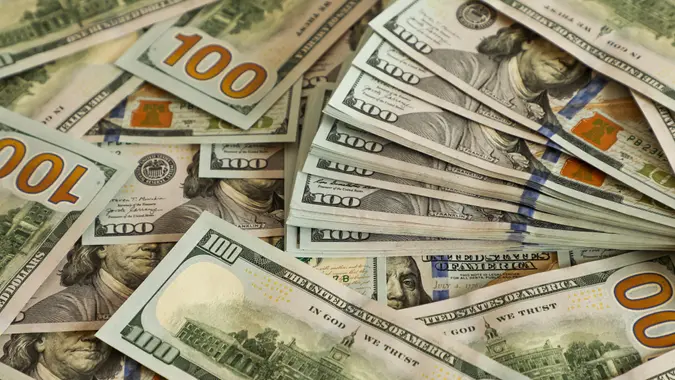Americans’ 4 Favorite Wealth ‘Hiding Places’ — How Much Should You Keep in Different Banks and Investment Accounts?

Commitment to Our Readers
GOBankingRates' editorial team is committed to bringing you unbiased reviews and information. We use data-driven methodologies to evaluate financial products and services - our reviews and ratings are not influenced by advertisers. You can read more about our editorial guidelines and our products and services review methodology.

20 Years
Helping You Live Richer

Reviewed
by Experts

Trusted by
Millions of Readers
Once you’ve amassed some savings, you’ll want to decide where to keep it. Deciding how much to keep in what type of account is a good problem to have, certainly, but there are some things you should keep in mind.
Here’s what to know about how much money you should keep in different places.
Cash in the Bank
Most Americans have at least one bank account, typically a checking or savings account. Some people have different bank accounts for different purposes — a checking account for monthly bills, a savings account for long-term savings for big expenses and maybe even a money market account for medium-term purchases.
Bank accounts should make it easier for you to save and spend your money, so make sure the number and type of accounts works for the way you manage your money. Keep in mind, however, that there is a limit to the amount of money you should keep in any given bank.
Deposits in banks in the U.S. are insured by the Federal Deposit Insurance Corporation, or FDIC. The FDIC was created in 1933 in response to the bank runs of the Great Depression. Many banks went out of business during the Depression, and many consumers lost their entire life savings. The government formed the FDIC to protect consumers from losing everything if their bank failed.
Today, the FDIC insures deposits up to $250,000 per person, per account type, per bank. Account types include individual accounts, joint accounts, some retirement accounts, trust accounts, and more.
This means that if a married couple, for example, each has their own checking account, plus they have a joint savings account, they would be insured for up to $750,000. Each of their three accounts would be insured for $250,000. IRAs and some self-directed retirement plans fall under a different ownership category, so that same married couple could be insured for up to $250,000 for each of their retirement accounts as well.
IF you have more than $250,000 in cash in a given account type, it’s time to move some of that money to a different bank. You can have as much money in the bank as you want, but anything over $250,000 in a single account type at a single bank won’t be insured.
Deposits at Credit Unions are similarly insured by the National Credit Union Insurance Association, or NCUA.
Brokerage and Investment Accounts
Investment and brokerage accounts are not FDIC- or NCUA-insured, even if your broker has a relationship with your credit union or bank. Stocks, mutual funds, ETFs and other investments can gain or lose value as they are bought and sold. For this reason, the amount of money you keep in these types of investments will depend on how much risk you’re willing to take. In other words, don’t invest more than you’re willing to lose. Choosing investments with low to moderate volatility can reduce your chances of losing money, but securities will always have some degree of risk.
The Securities Investor Protection Corporation (SIPC) protects investors if the brokerage firm that holds your account gets into financial trouble and needs to be liquidated. If this happens, up to $500,000 in securities and up to $250,000 of cash is insured in each account type. Some brokerage firms offer additional insurance protection beyond the SIPC limits.
Gold and Precious Metals
Some people like to invest in things they can touch, like gold and precious metals. In this case, your investment is as secure as the location where you store it, which could be in a safe in your home, in a safe deposit box at the bank, or in a hollowed-out book in your library.
Cash at Home
There’s always the prospect of keeping some cash at home. While you won’t earn anything on the money that’s in your sock drawer, it’ll be there if there’s an emergency.
Knowing this right place to stash your money — and how much to keep where — is an important part of protecting your wealth.
 Written by
Written by  Edited by
Edited by 

























